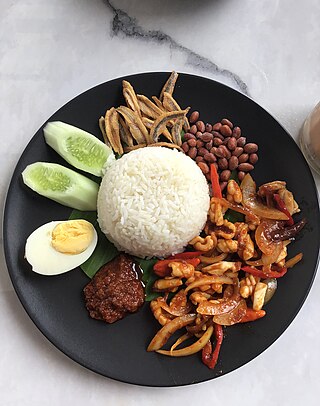
Nasi lemak is a dish originating in Malay cuisine that consists of fragrant rice cooked in coconut milk and pandan leaf. It is commonly found in Malaysia, where it is considered the national dish. It is also a native dish in neighbouring areas with significant ethnic Malay populations such as Singapore and Southern Thailand. In Indonesia, it can be found in several parts of Sumatra, especially the Malay regions of Riau, Riau Islands and Medan. It is considered an essential dish for a typical Malay-style breakfast. Nasi lemak is featured as a national dish in Malaysian tourism brochures and promotional materials.

Indonesian cuisine is a collection of various regional culinary traditions that formed in the archipelagic nation of Indonesia. There are a wide variety of recipes and cuisines in part because Indonesia is composed of approximately 6,000 populated islands of the total 17,508 in the world's largest archipelago, with more than 1,300 ethnic groups.

Malay cuisine is the traditional food of the ethnic Malays of Southeast Asia, residing in modern-day Malaysia, Indonesia, Singapore, Brunei, Southern Thailand and the Philippines as well as Cocos Islands, Christmas Island, Sri Lanka and South Africa.

Rijsttafel, a Dutch word that literally translates to "rice table", is an Indonesian elaborate meal adapted by the Dutch following the hidang presentation of nasi padang from the Padang region of West Sumatra. It consists of many side dishes served in small portions, accompanied by rice prepared in several different ways. Popular side dishes include egg rolls, sambals, satay, fish, fruit, vegetables, pickles, and nuts. In most areas where it is served, such as the Netherlands, and other areas of strong Dutch influence, it is known under its Dutch name.

Tahu goreng or Tauhu goreng is a generic name for any type of fried tofu dish in the cuisines of Indonesia, Brunei, Malaysia and Singapore.
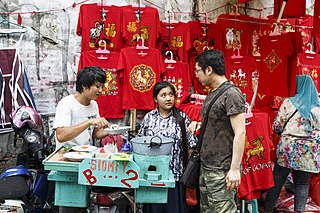
Chinese Indonesian cuisine is characterized by the mixture of Chinese with local Indonesian style. Chinese Indonesians, mostly descendant of Han ethnic Hokkien and Hakka speakers, brought their legacy of Chinese cuisine, and modified some of the dishes with the addition of Indonesian ingredients, such as kecap manis, palm sugar, peanut sauce, chili, santan and local spices to form a hybrid Chinese-Indonesian cuisine. Some of the dishes and cakes share the same style as in Malaysia and Singapore, known as Nyonya cuisine by the Peranakan.
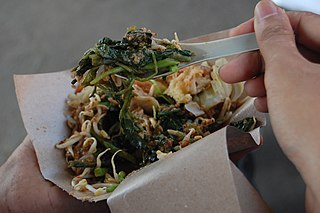
Pecel is a traditional Javanese salad with peanut sauce, usually eaten with steamed rice, lontong or ketupat.

Javanese cuisine is the cuisine of Javanese people, a major ethnic group in Indonesia, more precisely the province of Central Java, Yogyakarta and East Java.

Padang dish or Minangkabau dish is the cuisine of the Minangkabau people of West Sumatra, Indonesia. It is among the most popular cuisines in Maritime Southeast Asia. It is known across Indonesia as Masakan Padang after Padang, the capital city of Western Sumatra province. It is served in restaurants mostly owned by perantauan (migrating) Minangkabau people in Indonesian cities. Padang food is ubiquitous in Indonesian cities and is popular in neighboring Malaysia and Singapore.

Sundanese cuisine is the cuisine of the Sundanese people of Western Java, and Banten, Indonesia. It is one of the most popular foods in Indonesia. Sundanese food is characterised by its freshness; the famous lalab eaten with sambal and also karedok demonstrate the Sundanese fondness for fresh raw vegetables. Unlike the rich and spicy taste, infused with coconut milk and curry of Minangkabau cuisine, the Sundanese cuisine displays the simple and clear taste; ranged from savoury salty, fresh sourness, mild sweetness, to hot and spicy.
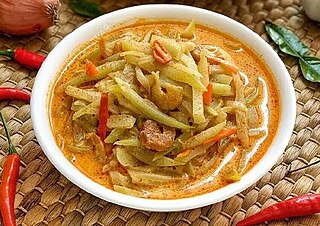
Sayur lodeh is a popular Indonesian vegetable soup prepared from vegetables cooked in coconut milk, and is most often associated with Javanese cuisine.

Lontong cap go meh is a Chinese Indonesian take on traditional Indonesian dishes, more precisely Javanese cuisine. It is lontong served with richly-flavoured dishes which include opor ayam chicken in coconut milk, sayur lodeh vegetable soup, hot and spicy liver, hard-boiled pindang egg, koya powder made of soy and dried shrimp or beef floss, pickles, chili paste and prawn cracker. Lontong cap go meh is usually consumed by the Chinese Indonesian community during the Cap go meh celebration.

Betawi cuisine is rich, diverse and eclectic, in part because the Betawi people that create them were composed from numbers of regional immigrants that came from various places in the Indonesian archipelago, as well as Chinese, Indian, Arab, and European traders, visitors and immigrants that were attracted to the port city of Batavia since centuries ago.

Ketupat, or kupat, or tipat is a Javanese rice cake packed inside a diamond-shaped container of woven palm leaf pouch. Originating in Indonesia, it is also found in Brunei, Malaysia, Singapore, southern Philippines, southern Thailand, Cambodia and Laos. It is commonly described as "packed rice", although there are other types of similar packed rice such as lontong and bakchang.

Soto is a traditional Indonesian soup mainly composed of broth, meat, and vegetables. Many traditional soups are called soto, whereas foreign and Western influenced soups are called sop.
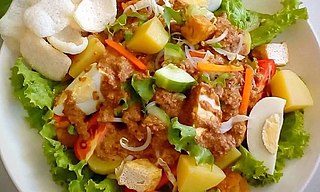
Gado-gado is an Indonesian salad of raw, slightly boiled, blanched or steamed vegetables and hard-boiled eggs, boiled potato, fried tofu and tempeh, and sliced lontong, served with a peanut sauce dressing.

Lontong sayur is an Indonesian traditional rice dish made of pieces of lontong served in coconut milk soup with shredded chayote, green bean, unripe jackfruit, tempeh, tofu, hard-boiled egg, sambal and krupuk.
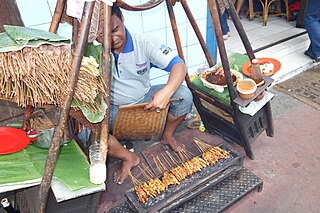
Madurese cuisine is the culinary tradition of the Madurese people from Madura Island in Indonesia. This cuisine is particularly well-known in the neighboring areas of East Java, as well as on the south coast of Kalimantan. As a leading salt production center in the Indonesian archipelago, Madurese dishes are often saltier compared to Eastern Javanese cuisine, although with significant Javanese influences.

Lontong balap is an Indonesian traditional rice dish, well known in Javanese cuisine, made of lontong, tauge, fried tofu, lentho, fried shallots, sambal petis and sweet soy sauce. East Javanese lontong and tofu recipes are known of their distinctive flavour, acquired from generous amount of petis. The origin of the dish is from Surabaya in East Java, Indonesia.
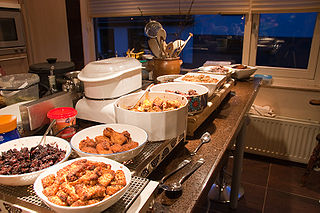
Indo cuisine is a fusion cooking and cuisine tradition, mainly existing in Indonesia and the Netherlands, as well as Belgium, South Africa and Suriname. This cuisine characterized of fusion cuisine that consists of original Indonesian cuisine with Eurasian-influences—mainly Dutch, also Portuguese, Spanish, French and British—and vice versa. Nowaday, not only Indo people consume Indo cuisine, but also Indonesians and Dutch people.



























